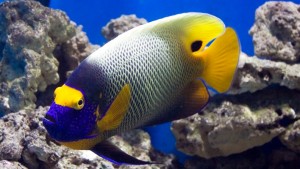You’re shopping at your LFS when you come across a juvenile specimen of a fish you’d love to buy but know you don’t have the tank space to accommodate once it reaches maturity. To justify the purchase, you think to yourself, “Thirty gallons is plenty of room for this cute little P. volitans right now. Besides, I can always upgrade to a larger tank when it gets bigger.”
While this can work out under ideal circumstances, it’s usually best to start fish out in a tank large enough to contain them at their adult size regardless of how small they may be at the time of purchase. Here are a few good reasons:
Budgets fluctuate
It’s hard to know what your financial future holds. You may have every intention of buying a larger tank in the future, but such upgrades can be quite costly. Not only will the tank itself set you back, but now you’re also going to need more substrate, more live rock, a larger lighting system, more salt, a bigger protein skimmer, a bigger heater, and so on. What happens if significant unanticipated expenses arise in the meantime or your income takes a downward turn? That lionfish is not going to stop growing until your budget gets back on track.
Schedules change
Even if you have the financial wherewithal to upgrade your tank, you may not have the time in your schedule to tackle the project when it comes due. Various and sundry life changes have a funny way of consuming extra time—starting a new job, getting assigned new responsibilities in your current job, the birth of a baby, needing to continue your education, etc.
Upgrading can be a hassle
Let’s face it, upgrading the size of your aquarium to keep pace with the maturation of a fish isn’t like buying new clothes for a growing child. It’s a major, messy project. Despite best intentions, the urge to procrastinate in the face of such an undertaking can be powerful. Meanwhile, the fish’s tail is hanging out one end of the tank, its snout is protruding out the other, and its dorsal spines are poking out the top.
It’s hard to know when the time is right
Finally, how do you determine exactly when it’s best to move a growing fish to a larger tank? Waiting until it physically outgrows the tank is cruel for obvious reasons—lack of swimming space, greater risk of injury, the inability to turn around at the ends of the tank without considerable maneuvering, etc. But well before that point, the fish may already be suffering as its waste output drives down water quality at an ever-increasing rate.
And once again, you have to ask yourself, when you do decide the time is right, will all of the other factors discussed here—budget, schedule, and motivation—be in line as well?



